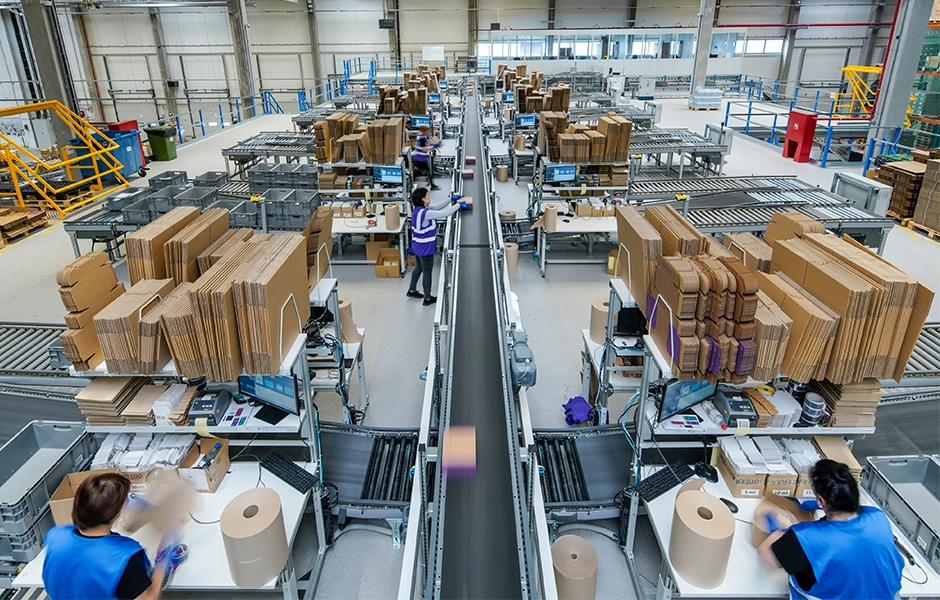Predictive Analytics: How to Leverage Data to Improve eCommerce Fulfillment

Data only matters if it drives smarter operations that enhance the customer experience. In e-commerce, every step of the journey counts—especially fulfillment. To improve it, retailers need real-time, reliable data to make informed decisions.

Radial Europe – Warsaw Fulfillment Site, Poland
Modern e-commerce generates tons of customer data, and connected systems offer insights into fulfillment performance, bottlenecks, and areas for improvement. But with data overload, the challenge is knowing what’s useful—and turning it into action with the right analytics tools.
So, how do you leverage data to improve e-commerce fulfillment?
Two types of analytics
There are two types of data analytics methodologies available to e-commerce retailers: descriptive analytics and predictive analytics. Both have their place and provide value.
- Descriptive Analytics: Provides insights into historical data over time. It tells you what happened, as well as why and how it happened. It is not based in real time and can only tell you what occurred in the past (e.g., tracking how often shipments went out on time over the last quarter). It may also tell you why shipments that were late missed their timeline (e.g., they all came from a certain supplier whose trucks were consistently late or that part of the e-commerce fulfillment center was understaffed during those days).
Historical data gives you clues as to how you can make changes to improve. It can also help you predict future outcomes based on repeated circumstances from the past. Descriptive data often identifies buying trends and customer behaviors, although it is limited to how customers behaved in the past and does not take into account new variables that may change future customer behavior.
- Predictive Analytics: Predictive analytics helps you forecast and plan ahead using historical and real-time data. It shows current customer behaviour and fulfillment performance, enabling proactive decisions. Powered by AI and machine learning, modern BI tools can even suggest next steps through dashboards and reports.
Of the two types of e-commerce analytics, predictive analytics has the most power to move the needle on customer experience via the fulfillment center.
Predictive analytics in e-commerce fulfillment centers
There are multiple ways predictive analytics can support fulfillment center operations:
- Planning. Predictive analytics can create models that help with fulfillment location planning or store fulfillment planning to ensure products and transportation are as close to the majority of customers as possible. It can also help identify and predict which fulfillment centers or store fulfillment operations need to be prioritized and have more resources allocated to meet demand.
- Design. How SKUs are placed across the fulfillment center impacts efficiency and speed. Using data on inventory velocity, pick-and-pack, replenishment, and employee performance can help optimize and streamline fulfillment center design and layout.
- Staffing. Predictive analytics can help forecast staffing needs during peak and slower seasons, as well as help identify accurate staffing numbers based on expected volume of inventory being sold. This helps ensure adequate capacity to meet eCommerce fulfillment expectations without wasting significant expense on overstaffing or being caught understaffed.

- Peak planning. Since the pandemic, peak season predictions have become more difficult to get right. Peak starts earlier than it did in previous years, and unexpected disruptions can throw even the best plans off. Predictive analytics can help identify trends, demand cycles, reverse logistics trends, and create more accurate real-time models for inventory peak planning.
- Accurate inventory management. Real-time inventory visibility coupled with predictive analytics enables e-commerce businesses to make more accurate inventory decisions that can help prevent stockouts by having enough inventory on-hand to meet customer expectations and fill customer orders without delay. It can also help prepare for supplier disruptions and pivot to head off customer impact before it happens, as well as predict seasonal and timely product demands by understanding customer buying behaviors, supplier availability, and market conditions.
- Order management. Modern fulfillment centers use order management systems that include predictive analytic capacities to help them run more efficiently, reduce costs, and improve order processing. Order management systems can help optimize every step of the e-commerce order fulfillment process.
Radial Predictive analytics for e-commerce fulfillment
Radial Reporting and Analytics provides a holistic view of retail operations to help optimize order fulfillment and transportation management operations with e-commerce metrics and insights into cross-business intelligence delivered in easily accessible reports and dashboards.
An unparalleled level of visibility enables you to:
- Make proactive changes that improve margins and reduce customer churn, efficiently manage retail operations, adjust fulfillment options to avoid overwhelming specific stores, and improve carrier management
- Gain near real-time visibility into inventory, service levels, outbound shipping, adjustments, and returns via an easy-to-understand visual dashboard
- Receive proactive alerts when critical parameters around stock levels, open orders, or SKU depth are out of tolerance
- Surface valuable insights to ensure key metrics are proactively reported, enabling you to quickly pivot based on evolving market dynamics and supply chain shifts
- Use real-time data to forecast the future and know what actions to take to capitalize on opportunities, forecast future demand and inventory planning, and optimize stock across your entire network
- Drill down into data to determine the root causes of issues and make adjustments before they impact customer experience and the bottom line
- Optimize e-commerce fulfillment nodes, track and correct decline rates, monitor stores to prevent decreasing service levels, and set up alerts to monitor and modify fulfillment and transportation operations
Predictive analytics plays a crucial role in running modern fulfillment operations. With tools such as Radial Reporting and Analytics, e-commerce retailers do not need to hire data scientists to make sense of their data.
Learn how to put the power of predictive analytics in the hands of e-commerce fulfillment center leaders to start improving your customer experience today.
Contact Us (EUR)
By submitting this form, you agree to our friendly privacy policy.
